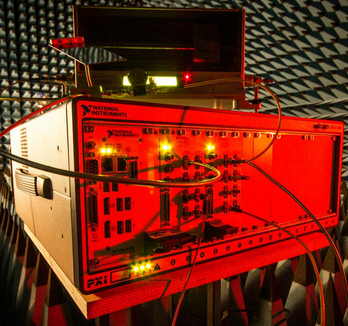New technology could fundamentally improve future wireless communications
 Novel full-duplex transceiver top device
Novel full-duplex transceiver top device
A new electronics technique that could allow a radio device to transmit and receive on the same channel at the same time (“full duplex,” or simultaneous, two-way transmission) has been developed by researchers at the University of Bristol’s Communication Systems and Networksresearch group. The technique can estimate and cancel out the interference from a device’s own transmission.
Today’s cell phones and other communication devices use twice as much of the radio spectrum as necessary. The new system requires only one channel (set of frequencies) for two-way communication,so it uses only half as much spectrum compared to current technology.
The new technology combines electrical balance isolation and active radio frequency cancellation. Their prototype can suppress interference by a factor of more than 100 million and uses low-cost, small-form-factor technologies, making it well suited to use in mobile devices such as smartphones.
Significant impacts on mobile and WiFi systems
For future cellular systems (such as 5G systems), the new technology would deliver increased capacity and data rates, or alternatively, the network operators could provide the same total network capacity with fewer base-station sites, reducing the cost and environmental impact of running the network.
In today’s mobile devices, a separate filtering component is required for each frequency band, and because of this, today’s mobiles phone do not support all of the frequency channels available internationally. Different devices are manufactured for different regions of the world, so there are currently no 4G phones capable of unrestricted global roaming.
In Wi-Fi systems, the new design would double the capacity of a Wi-Fi access point, allowing for more simultaneous users or higher data rates.
Replacing these filters with the research team’s duplexer circuit would create smaller and cheaper devices, and would allow manufacturers to produce a single model for the entire world. This would enable global roaming on 4G and would further decrease cost through greater economies of scale.
The team had published papers about their research in the IEEE Journal on Selected Areas in Communications special issue on full duplex radio, and in this month’s issue of the IEEE Communications Magazine and has filed patents.
Abstract of Electrical balance duplexing for small form factor realization of in-band full duplex
Transceiver architectures utilizing various self-interference suppression techniques have enabled simultaneous transmission and reception at the same frequency. This full-duplex wireless offers the potential for a doubling of spectral efficiency; however, the requirement for high transmit-to-receive isolation presents formidable challenges for the designers of full duplex transceivers. Electrical balance in hybrid junctions has been shown to provide high transmit- to-receive isolation over significant bandwidths. Electrical balance duplexers require just one antenna, and can be implemented on-chip, making this an attractive technology for small form factor devices. However, the transmit-toreceive isolation is sensitive to antenna impedance variation in both the frequency domain and time domain, limiting the isolation bandwidth and requiring dynamic adaptation. Various contributions concerning the implementation and performance of electrical balance duplexers are reviewed and compared, and novel measurements and simulations are presented. Results demonstrate the degradation in duplexer isolation due to imperfect system adaptation in user interaction scenarios, and requirements for the duplexer adaptation system are discussed.
Abstract of Optimum Single Antenna Full Duplex Using Hybrid Junctions
This paper investigates electrical balance (EB) in hybrid junctions as a method of achieving transmitter-receiver isolation in single antenna full duplex wireless systems. A novel technique for maximizing isolation in EB duplexers is presented, and we show that the maximum achievable isolation is proportional to the variance of the antenna reflection coefficient with respect to frequency. Consequently, antenna characteristics can have a significant detrimental impact on the isolation bandwidth. Simulations that include embedded antenna measurements show a mean isolation of 62 dB over a 20-MHz bandwidth at 1.9 GHz but relatively poor performance at wider bandwidths. Furthermore, the operational environment can have a significant impact on isolation performance. We present a novel method of characterizing radio reflections being returned to a single antenna. Results show as little as 39 dB of attenuation in the radio echo for a highly reflective indoor environment at 1.9 GHz and that the mean isolation of an EB duplexer is reduced by 7 dB in this environment. A full duplex architecture exploiting EB is proposed.









Post a Comment